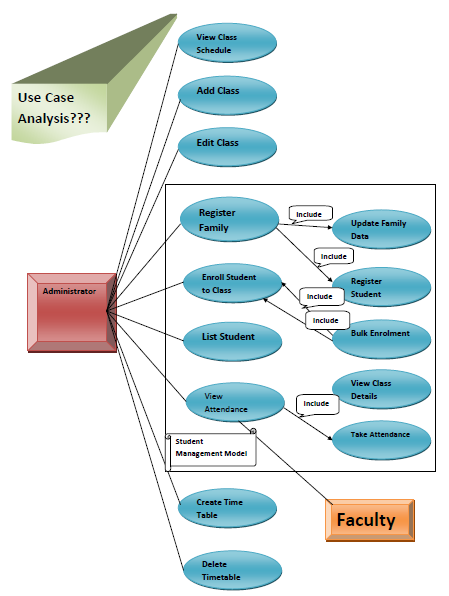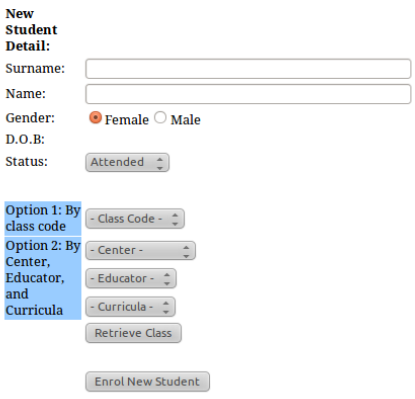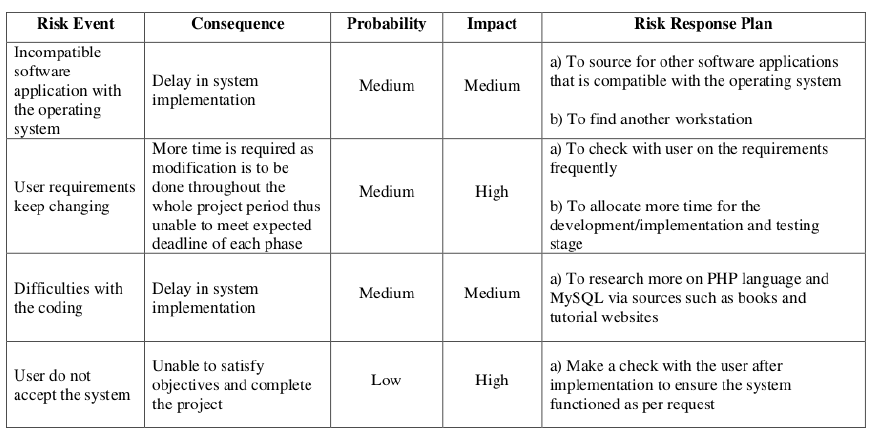Cost: INR 290/-
Get This Project
 Figure 2.1: Project Development Phases[/caption]
Project management skills are put to good use for this project. Having gone through project management modules in Time Series Analysis, Optimization and with two interns Project Management for Business and IT respectively, they enhanced my knowledge on managing a project. Project management focuses on achieving the objectives by applying five processes presented in Figure.
RESOURCES
Systems Development Life Cycle (SDLC) is the most common process adopted to develop a project and not surprisingly, this project is following this model too. To be precise, waterfall model is being applied. Waterfall model is a sequential model process where the input of a phase actually results from the previous phase.
[caption id="attachment_19195" align="alignnone" width="753"]
Figure 2.1: Project Development Phases[/caption]
Project management skills are put to good use for this project. Having gone through project management modules in Time Series Analysis, Optimization and with two interns Project Management for Business and IT respectively, they enhanced my knowledge on managing a project. Project management focuses on achieving the objectives by applying five processes presented in Figure.
RESOURCES
Systems Development Life Cycle (SDLC) is the most common process adopted to develop a project and not surprisingly, this project is following this model too. To be precise, waterfall model is being applied. Waterfall model is a sequential model process where the input of a phase actually results from the previous phase.
[caption id="attachment_19195" align="alignnone" width="753"] Figure 3.1: SDLC Phases[/caption]
There are five phases in this model and the first phase is the planning stage. The planning stage determines the objectives of the project and whether the project should be given the green light to proceed. This is where the proposal submission comes into picture. After obtaining the approval, the next phase is analysis. Gathering and analysing the system and user requirements is essential for entry to the design step.
[caption id="attachment_19197" align="alignnone" width="679"]
Figure 3.1: SDLC Phases[/caption]
There are five phases in this model and the first phase is the planning stage. The planning stage determines the objectives of the project and whether the project should be given the green light to proceed. This is where the proposal submission comes into picture. After obtaining the approval, the next phase is analysis. Gathering and analysing the system and user requirements is essential for entry to the design step.
[caption id="attachment_19197" align="alignnone" width="679"] Figure 3.2: Comparison of web servers[/caption]
After deciding on the scripting language and database, next is to select the web server that can support them. Web server is necessary for the delivery of web content to the web browser. As such, Apache HTTP server which has performance similar with other ’high-performance’ server is considered.
Thereafter, research and actual testing have been performed to see the outcome of the various servers listed in the Figure below. These servers include PHP and MySQL in their installation packages thus allowing smoother and simpler download process. However, based on the performance and interface, Wamp or LAMP server is the preferred choice.
SYSTEM ANALYSIS AND DESIGN
In order to provide a clearer picture of the functionality provided by the student management module, we have done a use case analysis. Figure below is a use case diagram to present the functionality in the student management module.
[caption id="attachment_19200" align="alignnone" width="449"]
Figure 3.2: Comparison of web servers[/caption]
After deciding on the scripting language and database, next is to select the web server that can support them. Web server is necessary for the delivery of web content to the web browser. As such, Apache HTTP server which has performance similar with other ’high-performance’ server is considered.
Thereafter, research and actual testing have been performed to see the outcome of the various servers listed in the Figure below. These servers include PHP and MySQL in their installation packages thus allowing smoother and simpler download process. However, based on the performance and interface, Wamp or LAMP server is the preferred choice.
SYSTEM ANALYSIS AND DESIGN
In order to provide a clearer picture of the functionality provided by the student management module, we have done a use case analysis. Figure below is a use case diagram to present the functionality in the student management module.
[caption id="attachment_19200" align="alignnone" width="449"] Figure 4.1: use case analysis[/caption]
Under the existing student management module, the administrator has to first register the family. This includes the parent’s particulars and home details. After submitting these data, the administrator will be directed to the student page whereby the student information is to be submitted. Figure below provides the interface of the existing student registration site. For easy navigation, the registration of the student and enrolment to the class has been combined into one process.
[caption id="attachment_19201" align="alignnone" width="415"]
Figure 4.1: use case analysis[/caption]
Under the existing student management module, the administrator has to first register the family. This includes the parent’s particulars and home details. After submitting these data, the administrator will be directed to the student page whereby the student information is to be submitted. Figure below provides the interface of the existing student registration site. For easy navigation, the registration of the student and enrolment to the class has been combined into one process.
[caption id="attachment_19201" align="alignnone" width="415"] Figure 4.2: Student registration process[/caption]
DATABASE DESIGN AND DEVELOPMENT
The first step is to create the database as shown in Figure below. The default storage engine in this MySQL server is InnoDB which has commit, rollback, and crash-recovery capabilities to protect user data. Following that is to create the tables in the database.
[caption id="attachment_19202" align="alignnone" width="1115"]
Figure 4.2: Student registration process[/caption]
DATABASE DESIGN AND DEVELOPMENT
The first step is to create the database as shown in Figure below. The default storage engine in this MySQL server is InnoDB which has commit, rollback, and crash-recovery capabilities to protect user data. Following that is to create the tables in the database.
[caption id="attachment_19202" align="alignnone" width="1115"] Figure 5.1: Database creation in phpMyAdmin[/caption]
Figure below gives a view of the table creation.
[caption id="attachment_19203" align="alignnone" width="1130"]
Figure 5.1: Database creation in phpMyAdmin[/caption]
Figure below gives a view of the table creation.
[caption id="attachment_19203" align="alignnone" width="1130"] Figure 5.2: Table creation in phpMyAdmin[/caption]
SYSTEM AND DATABASE TESTING
Testing is the last phase of this project. This is the stage where it shows whether the system and database are working as desired. Otherwise, further rectification is required. Tests have been conducted and recorded below to show the results.
[caption id="attachment_19206" align="alignnone" width="645"]
Figure 5.2: Table creation in phpMyAdmin[/caption]
SYSTEM AND DATABASE TESTING
Testing is the last phase of this project. This is the stage where it shows whether the system and database are working as desired. Otherwise, further rectification is required. Tests have been conducted and recorded below to show the results.
[caption id="attachment_19206" align="alignnone" width="645"] Figure 6.1: Test[/caption]
PROJECT MANAGEMENT
Work breakdown structure
The Work Breakdown Structure provides a clear picture of the items that are required to be completed for the project work scope. It is arranged in a tree structure manner to show all sub-sections required to be accomplished in each phase throughout the project.
Risk management
Every project has uncertainties and they may affect the project success. These uncertainties are known as risk. There is a need to determine the risks involved in the project to reduce the chance of its occurrence as well as develop a plan to either mitigate or avoid the risks that have been identified.
[caption id="attachment_19209" align="alignnone" width="870"]
Figure 6.1: Test[/caption]
PROJECT MANAGEMENT
Work breakdown structure
The Work Breakdown Structure provides a clear picture of the items that are required to be completed for the project work scope. It is arranged in a tree structure manner to show all sub-sections required to be accomplished in each phase throughout the project.
Risk management
Every project has uncertainties and they may affect the project success. These uncertainties are known as risk. There is a need to determine the risks involved in the project to reduce the chance of its occurrence as well as develop a plan to either mitigate or avoid the risks that have been identified.
[caption id="attachment_19209" align="alignnone" width="870"] Figure 7.1: Risk Assessment Matrix[/caption]
After identifying and determining the risks, they are recorded in a table called the risk assessment matrix. This matrix lists the severity which is also known as the impact level in terms of High, Medium and Low. In addition to those details, the action plan that can be taken for each of the risks is clearly stated too.
CONCLUSIONS
Simplicity is never simple. As we have seen in this project, the process of creating a user- friendly and straightforward platform that facilitates the administrator’s job is one filled with complexity. From understanding user requirements to system design and finally system prototype and finalization, every step requires in-depth understanding and commitment towards achieving the objectives of the project.
Although the student database management module is not fully integrated to the system and used on real time, the system prototype demonstrates easy navigation and data are stored in a systematic way. Overall, efficiency has improved and work processes simplified. Although all the objectives have been met, the system still has room for improvement. The system is robust and flexible enough for future upgrade using advanced technology and devices.
CRITICAL REVIEWS
In the process of doing this project, obstacles have been encountered. I have learnt to be more flexible in resolving issues. One of the situations that I have faced was when I had installed MySQL server, but it did not work. Then I tried to troubleshoot, research online and did a couple of re-installation but to no avail. Then I installed XAMPP, it did not work out too. Some how I did get rid of this problem but I did not like XAMPP server. Therefore I decided to install LAMP server. Yes it worked fine. At the end I found that I had installed multiple server and hence system was confused which server is to be used i.e. conflicts with MySQL. Then I stopped all server running on my laptop and decicded to start only LAMP server and it worked fine.
Source: IIT Guwahati
Authors: Ajay Shankar Bidyarthy | Abhishek Kumar
Figure 7.1: Risk Assessment Matrix[/caption]
After identifying and determining the risks, they are recorded in a table called the risk assessment matrix. This matrix lists the severity which is also known as the impact level in terms of High, Medium and Low. In addition to those details, the action plan that can be taken for each of the risks is clearly stated too.
CONCLUSIONS
Simplicity is never simple. As we have seen in this project, the process of creating a user- friendly and straightforward platform that facilitates the administrator’s job is one filled with complexity. From understanding user requirements to system design and finally system prototype and finalization, every step requires in-depth understanding and commitment towards achieving the objectives of the project.
Although the student database management module is not fully integrated to the system and used on real time, the system prototype demonstrates easy navigation and data are stored in a systematic way. Overall, efficiency has improved and work processes simplified. Although all the objectives have been met, the system still has room for improvement. The system is robust and flexible enough for future upgrade using advanced technology and devices.
CRITICAL REVIEWS
In the process of doing this project, obstacles have been encountered. I have learnt to be more flexible in resolving issues. One of the situations that I have faced was when I had installed MySQL server, but it did not work. Then I tried to troubleshoot, research online and did a couple of re-installation but to no avail. Then I installed XAMPP, it did not work out too. Some how I did get rid of this problem but I did not like XAMPP server. Therefore I decided to install LAMP server. Yes it worked fine. At the end I found that I had installed multiple server and hence system was confused which server is to be used i.e. conflicts with MySQL. Then I stopped all server running on my laptop and decicded to start only LAMP server and it worked fine.
Source: IIT Guwahati
Authors: Ajay Shankar Bidyarthy | Abhishek Kumar